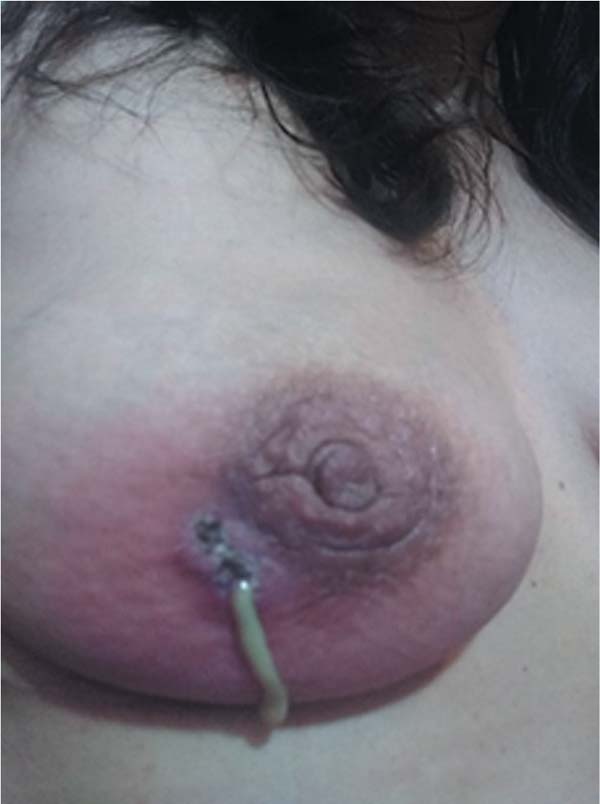

Case Report - Year 2025 - Volume 40Issue 1
Idiopathic Granulomatous Mastitis after Silicone Prosthesis Implantation - Case Report
Mastite granulomatosa idiopática após implante de prótese de silicone - Relato de caso
ABSTRACT
Idiopathic granulomatous mastitis (IGM) is a rare disease of unknown etiology. In the present case report, we discuss a 45-year-old patient, with a 40-month breastfeeding history, who underwent prosthesis implant in both breasts and developed IGM. However, we do not know when the disease developed. We removed the prostheses because they produced seroma continuously for a year, and there was no definitive diagnosis. With symptoms worsening until approximately two years after implant surgery, we established the clinical diagnosis of IGM.We aimed to discuss whether the trauma due to implantation could have triggered the disease. We requested several imaging exams and biopsies, and the clinical diagnosis predominated. The patient developed a fistula that lasted for 11 months. She underwent surgery to remove it and treatment with immunosuppressants. Until the end of this report, her illness remained in remission, although there are still nodules in both breasts. Due to treatment controversies, the patient requires monthly follow-up.
Keywords: diagnosis, differential; fistula; granulomatous mastitis; silicone elastomer; persistent infection
RESUMO
Mastite granulomatosa idiopática (MGI) é uma doença rara e de etiologia desconhecida. Neste relato de caso, apresentamos uma paciente de 45 anos com histórico de amamentação de 40 meses, que realizou implante de prótese em ambos os seios e desenvolveu MGI; porém, não se sabe em que momento a doença foi desencadeada. Realizamos a retirada das próteses, pois produzia seroma continuamente durante um ano e não havia diagnóstico definitivo. Coma piora dos sintomas depois de dois anos da cirurgia do implante, chegou-se ao diagnóstico clínico de MGI. A paciente desenvolveu uma fístula que durou 11 meses, sendo retirada por procedimento cirúrgico e tratamento com imunossupressor. Até o final deste relato, a doença permanece em remissão apesar de ainda haver nódulos em ambos os seios. Devido às controvérsias de tratamento, a paciente requer acompanhamento mensal.
Palavras-chave: diagnóstico diferencial; elastômeros de silicone; fístula; infecção persistente; mastite granulomatosa
Introduction
Kessler and Wolloch were the first authors to describe idiopathic granulomatous mastitis (IGM) in 1972.1 Itis a benign chronic inflammation of the breast of unknown etiology1,2 that is more prevalent in young, non-white women of childbearing age with a recent history of breastfeeding, who typically had their last child within five years of the onset of the clinical picture. However, there are reports of IGM cases in nulliparous women and men.2,3
Diagnosis is often late, and treatment is controversial, negatively impacting quality of life. There is no consensus on appropriate management, including medication selection or the need for surgery.1
Karanlik et al. concluded that surgery with corticosteroid therapy is the most appropriate treatment.5 The findings of the study by Sheybani et al. indicate that the combined treatment with prednisone and methotrexate controls the disease, but discontinuation can lead to relapses.6
The diagnosis of IGM is only established after ruling out all diseases that may present with breast granulomas and carcinoma-like features.2,3,7 Other diseases commonly confused with IGM include sarcoidosis, tuberculosis, and granulomatous polyangiitis.5
Although autoimmunity is a preponderant factor in the etiology of the disease, other factors are also proposed, such as hormonal disorders and infectious diseases.1,6,8 More specific factors are also described, such as trauma,9,10 ruptured silicone implants, fat necrosis,11 and hyperprolactinemia induced by antipsychotic medications. Infection by the bacterium Corynebacterium kroppenstedtii occurs in many IGM cases.4,11
Due to the lack of data on treatment, diagnosis, and its controversial management, the present study aimed to describe an atypical case of IGM after silicone implantation without prosthetic extravasation or rupture.
Case Report
The patient is a 45-year-old woman with a history of breastfeeding 2 children (4 and 40 months old). In 2019, she stopped breastfeeding and, in 2020, underwent silicone implants, without mastopexy or previous contraindications. The patient had panic disorder, attention deficit, and occasionally used methylphenidate (Ritalin; Novartis), cannabidiol, and clonazepam (Rivotril; Roche).
Before implantation, the patient was physically active but smoked and consumed alcohol on weekends. She terminated smoking and drinking after the onset of symptoms. Postoperatively, she developed pain and lymphadenopathy in her right armpit (►Figure 1), which progressed to edema and seroma in her right breast. The patient underwent several sterile fluid aspirations in 2021, and an ultrasound revealed a “heterogeneous nodule.”
In 2022, the patient underwent prosthesis removal, and capsule analysis revealed synovial metaplasia. However, in March of the same year, the patient experienced recurrent breast inflammation, with mastitis, abscesses, and fistulas (►Figure 2). Antibacterial therapies provided temporary relief, but symptoms returned within days of completing treatment. The patient suffered from constant pain, limited movement, open wounds, loss of appetite, vomiting, diarrhea, weight loss, and weakness.
Hyperoxygenation sessions performed in September 2022 were ineffective. In December, after further surgery for fistula removal, a biopsy suggested chronic idiopathic mastitis. The use of immunosuppressants and antibiotics resulted in clinical improvement. Currently, the patient continues to have bilateral nodules and a few episodes of pain, but with a risk of recurrence.
Discussion
A chronic inflammation with no known trigger, IGM may be associated with trauma, infection, or foreign bodies.2 Studies suggest that silicone implants may release particles that trigger autoimmune reactions, exacerbated by the presence of seroma. In the case presented, seroma had no direct correlation with IGM, but surgical trauma can trigger both seroma and IGM.10,12
Since the patient’s first symptom was late seroma, we investigated a direct association between this lesion and granulomatous mastitis but found none. In contrast, Fleury et al. analyzed the silicone-induced granuloma of the breast implant capsule (SIGBIC). These authors studied 2,891 breast magnetic resonance imaging (BMRI) scans and selected 830 for breast implant evaluation. The BMRI scans of 27.1% of implants showed signs of SIGBIC. Among them, 12.7% presented with intracapsular seroma.12 The authors reported a lack of literature, especially regarding late seroma. These cases require BMRI scans with contrast, which rarely occur.12 Our patient did not undergo a BMRI scan while she had implants.
Idiopathic granulomatous mastitis is a bilateral condition, while lesions, fistulas, or abscesses are unilateral, with rare exceptions. Although the exact pathogenesis of IGM is unknown, it has several stages. Nonspecific lobulitis leads to multiple foci of deformed lobules, which result in abscesses. Next, a reactive lymphoplasmacytic infiltration causes suppurative necrosis, followed by granulomatous formation.13
However, the most accepted theory for IGM pathogenesis is a non-puerperal secretion process resulting from hormonal disturbances. This secretion causes ductal ectasia,13 with mammary duct dilation and consequent secretion stasis. Stasis may result in mechanical or chemical internal rupture of the mammary ducts, leading to permanent inflammation13-15 and autoimmunity triggered by trauma or chemical alterations.15 Moreover, the disease usually appears within five years after lactation.1,3,15Therefore, this would be a plausible explanation for this patient’s case because she had been breastfeeding for 40 months, in addition to the potential reaction to the implantation trauma. The patient was not using oral contraceptives.
In addition, there is a possible association between IGM and psychiatric history. Studies indicate that C. kroppenstedtii is present in 37% of IGM cases in patients with psychiatric disorders14
Diagnosis must rely on tissue histology of the affected area. Although a mammography may be helpful, it does not establish a definitive diagnosis, as single masses can be mistaken for a breast abscess. An ultrasound can reveal parenchymal architectural distortion and fistula formation;7 it may also help monitor the therapeutic response.15 Magnetic resonance imaging, on the other hand, has low specificity.15 None of the tests requested determined an IGM diagnosis for our patient.
The patient’s treatment involved implant removal and long-term antibiotic administration. A surgery for fistula removal occurred after 1 year and 2 months. Finally, the patient underwent immunosuppression with prednisone, 80 mg daily for 60 days. The disease is now in remission.
The treatment is challenging and includes immunosuppressants, corticosteroids, and mastectomy in severe cases. Although invasive, mastectomy is considered a definitive solution for recurrences or failure of conservative treatments.16
Conclusion
The case report did not provide a definitive explanation for the cause of the disease, as the patient suffered trauma from the silicone implant, had breastfed for 5 years before the onset of symptoms, had a history of psychotropic substance use, and there is uncertainty about autoimmunity. The case herein discussed highlights the importance of considering the possibility of IGM in patients with silicone implants, even without ruptured implants.
References
1. Maione C, Palumbo VD, Maffongelli A, Damiano G, Buscemi S, Spinelli G, et al. Diagnostic techniques and multidisciplinary approach in idiopathic granulomatous mastitis: a revision of the literature. Acta Biomed 2019;90(01):11-15. Doi: 10.23750/ abm.v90i1.6607
2. Wolfrum A, Kümmel S, Theuerkauf I, Pelz E, Reinisch M. Granulomatous Mastitis: A Therapeutic and Diagnostic Challenge. Breast Care (Basel) 2018;13(06):413-418. Doi: 10.1159/000495146
3. Pala EE, Ekmekci S, Kilic M, Dursun A, Colakoglu G, Karaali C, et al. Granulomatous Mastitis: A Clinical and Diagnostic Dilemma. Turk Patoloji Derg 2022;38(01):40-45. Doi: 10.5146/tjpath.2021. 01554
4. Ennasser H, Raoudi JE, Taheri H, Saadi H, Mimouni A. [Idiopathic granulomatous mastitis: 4 case-reports and literature review]. Pan Afr Med J 2020;37:128. Doi: 10.11604/pamj.2020.37.128.25301
5. Karanlik H, Ozgur I, Simsek S, Fathalizadeh A, Tukenmez M, Sahin D, et al. Can Steroids plus Surgery Become a First-Line Treatment of Idiopathic Granulomatous Mastitis? Breast Care (Basel) 2014;9 (05):338-342. Doi: 10.1159/000366437
6. Sheybani F, Sarvghad M, Naderi H, Gharib M. Treatment for and clinical characteristics of granulomatous mastitis. Obstet Gynecol 2015;125(04):801-807. Doi: 10.1097/AOG.0000000000000734
7. Tekgöz E, Çolak S, Çinar M, Yilmaz S. Treatment of idiopathic granulomatous mastitis and factors related with disease recurrence. Turk J Med Sci 2020;50(05):1380-1386. Doi: 10.3906/ sag-2003-93
8. Erhan Y, Veral A, Kara E, Ozdemir N, Kapkac M, Ozdedeli E, et al. A clinicopthologic study of a rare clinical entity mimicking breast carcinoma: idiopathic granulomatous mastitis. Breast 2000;9 (01):52-56. Doi: 10.1054/brst.1999.0072
9. Kornfeld HW, Mitchell KB. Management of idiopathic granulomatous mastitis in lactation: case report and review of the literature. Int Breastfeed J 2021;16(01):23. Doi: 10.1186/ s13006-021-00370-8
10. Illman JE, Terra SB, Clapp AJ, Hunt KN, Fazzio RT, Shah SS, Glazebrook KN. Granulomatous diseases of the breast and axilla: radiological findings with pathological correlation. Insights Imaging 2018;9(01):59-71. Doi: 10.1007/s13244-017-0587-9
11. Wong SCY, Poon RWS, Chen JHK, Tse H, Lo JYC, Ng TK, et al. Corynebacterium kroppenstedtii Is an Emerging Cause of Mastitis Especially in Patients With Psychiatric Illness on Antipsychotic Medication. Open Forum Infect Dis 2017;4(02):ofx096. Doi: 10.1093/ofid/ofx096
12. Fleury EdFC, D’Alessandro GS, Wludarski SCL. Silicone-Induced Granuloma of Breast Implant Capsule (SIGBIC): Histopathology and Radiological Correlation. J Immunol Res 2018;2018:6784971. Doi: 10.1155/2018/6784971
13. Altintoprak F, Kivilcim T, Ozkan OV. Aetiology of idiopathic granulomatous mastitis. World J Clin Cases 2014;2(12): 852-858. Doi: 10.12998/wjcc.v2.i12.852
14. Al-Khaffaf B, Knox F, Bundred NJ. Idiopathic granulomatous mastitis: a 25-year experience. J Am Coll Surg 2008;206(02): 269-273. Doi: 10.1016/j.jamcollsurg.2007.07.041
15. Gudimani SC, Rohit KC, Mithun VV, Gowda CK, Deepa AB. Idiopathic granulomatous mastitis: diagnostic and therapeutic challenges to general surgeon. Breast Dis 2015;35(01):67-72. Doi: 10.3233/BD-140375
16. Zhou F, Liu L, Liu L, Yu L, Wang F, Xiang Y, et al. Comparison of Conservative versus Surgical Treatment Protocols in Treating Idiopathic Granulomatous Mastitis: A Meta-Analysis. Breast Care (Basel) 2020;15(04):415-420. Doi: 10.1159/000503602
1. Postgraduate Program in Health Sciences, Universidade do Sul de Santa Catarina,
Tubarão, SC, Brazil
Address for correspondence Fabiana Schuelter-Trevisol, Programa de Pós-Graduação em Ciências da Saúde, Universidade do Sul de Santa Catarina, Tubarão, SC, 88704-900, Brazil (e-mail: fastrevisol@gmail.com fabiana.trevisol@ulife.com.br).
Artigo submetido: 05/09/2024.
Artigo aceito: 14/07/2025.
Conflict of Interests
The authors have no conflict of interests to declare.







 Read in Portuguese
Read in Portuguese
 Read in English
Read in English
 PDF PT
PDF PT
 Print
Print
 Send this article by email
Send this article by email
 How to Cite
How to Cite
 Mendeley
Mendeley
 Pocket
Pocket
 Twitter
Twitter